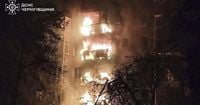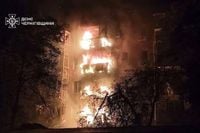As the chill of another Ukrainian winter approaches, the country’s battered power grid is once again in the crosshairs of relentless Russian attacks. On October 16, 2025, Russia unleashed one of its most intense bombardments yet, firing over 300 drones and 37 missiles at energy facilities across Ukraine, according to Ukraine’s national energy operator, Ukrenergo. The result: blackouts in eight regions, outages in the capital Kyiv, and a halt to natural gas extraction in the central Poltava region. The barrage is part of what Ukrainian officials have called Russia’s strategy of “weaponizing winter” – a campaign to freeze Ukraine into submission as temperatures drop and energy needs spike.
President Volodymyr Zelenskyy, facing this mounting crisis, prepared to make a personal appeal to U.S. President Donald Trump at the White House, seeking more American-made air defense systems, long-range missiles, and joint drone production agreements. Kyiv officials also emphasized their desire for tougher international economic sanctions on Moscow, hoping to cut off the financial lifelines fueling Russia’s war effort.
The human cost of this latest assault is stark. DTEK, Ukraine’s largest private energy company, reported widespread outages in Kyiv and confirmed it had to stop natural gas extraction in Poltava because of the strikes. Naftogaz, the state-owned oil and gas company, revealed that natural gas infrastructure was damaged for the sixth time in October alone, underscoring the persistent vulnerability of Ukraine’s energy sector. In a message posted to Telegram, Zelenskyy accused Russia of using cluster munitions and deliberately striking the same sites repeatedly to target emergency crews and engineers scrambling to restore power. “This fall, the Russians are using every single day to strike our energy infrastructure,” he said.
According to the Associated Press, Russia claims its attacks are aimed solely at military targets. However, the pattern and timing of these strikes – intensifying as winter draws near – suggest a deliberate effort to inflict maximum hardship on Ukrainian civilians. Ukrainian officials have long warned that Moscow’s goal is to break the country’s resolve by plunging millions into darkness and cold, a tactic that has become all too familiar since Russia’s invasion began more than three years ago.
Ukraine has not remained passive in the face of these attacks. In a move that signals Kyiv’s determination to hit back, the Ukrainian General Staff announced that its forces struck the Saratov oil refinery in Russia’s Saratov region on October 16, marking the second such attack on the facility in two months. The refinery lies about 500 kilometers from the Ukrainian border and is considered vital to Russia’s economy and war effort. While Moscow offered no immediate comment on the claim, Ukraine’s strategy of targeting Russian oil infrastructure is seen as an attempt to disrupt the logistical backbone supporting Russian military operations.
As the front lines grind along a roughly 1,000-kilometer stretch through eastern and southern Ukraine, the war has become a punishing battle of attrition. Ukraine’s defenders, while resilient, face an adversary with greater numbers and resources. The country’s vast territory – almost the size of Texas – makes it a daunting challenge to defend every inch from aerial assault. This reality is driving Zelenskyy’s urgent plea for more sophisticated Western weaponry, especially systems capable of intercepting drones and missiles before they can cripple critical infrastructure.
The diplomatic stakes are equally high. Hours before his scheduled meeting with Zelenskyy, President Trump spoke by phone with Russian President Vladimir Putin in a call that reportedly lasted more than two hours. According to the White House, the conversation was initiated by the Kremlin and centered on potential steps toward ending the war. After the call, Trump announced plans to meet Putin in Budapest, Hungary, though no date has been set. In a post on Truth Social, Trump wrote, “I believe great progress was made with today’s telephone conversation,” and promised to discuss the call and “much more” during his meeting with Zelenskyy.
This flurry of diplomacy comes at a crucial juncture. Zelenskyy’s visit to Washington is intended to secure not just immediate military aid, but also longer-term commitments that could alter the trajectory of the conflict. Kyiv is specifically seeking cruise missiles, advanced air defense systems, and agreements for joint drone production – all seen as essential to countering Russia’s aerial onslaught and regaining the initiative on the battlefield. At the same time, Ukrainian officials are pressing for harsher sanctions on Moscow, hoping to tighten the economic vise on the Kremlin.
Meanwhile, the Russian side continues to frame its campaign as strictly military in nature. State media and officials assert that only legitimate military targets are being struck, even as evidence mounts of widespread civilian hardship resulting from attacks on the energy grid. The Kremlin’s narrative has found some traction among its domestic audience, but international observers – including the United Nations and human rights organizations – have repeatedly condemned the targeting of civilian infrastructure as a violation of international law.
For ordinary Ukrainians, the reality is a daily struggle to cope with uncertainty. Rolling blackouts disrupt schools, hospitals, and businesses. Emergency workers risk their lives to repair damaged substations and pipelines, often under the threat of renewed bombardment. The specter of a winter without reliable heat or electricity looms large, fueling anxiety and anger in equal measure.
In response, Ukrainian society has displayed remarkable resilience. Local governments and community groups have mobilized to set up warming centers, distribute generators, and provide support to the most vulnerable. Yet, as the scale and sophistication of Russian attacks grow, so too does the sense that Ukraine’s fate may hinge on decisions made far from its own borders – in Washington, Brussels, and now Budapest.
As President Zelenskyy arrives in Washington, the stakes could hardly be higher. The outcome of his talks with President Trump may determine not only Ukraine’s ability to keep the lights on this winter, but also the broader contours of a war that shows no sign of ending soon. With Russia intensifying its campaign to weaponize winter, and Ukraine striking back at the infrastructure underpinning Russia’s war machine, the next moves on the diplomatic and military chessboard could shape the fate of millions in the months ahead.
In the shadow of blackouts and bombardments, Ukraine’s struggle for survival continues, powered by a mix of defiance, desperation, and hope that international partners will not let the country face the darkness alone.


